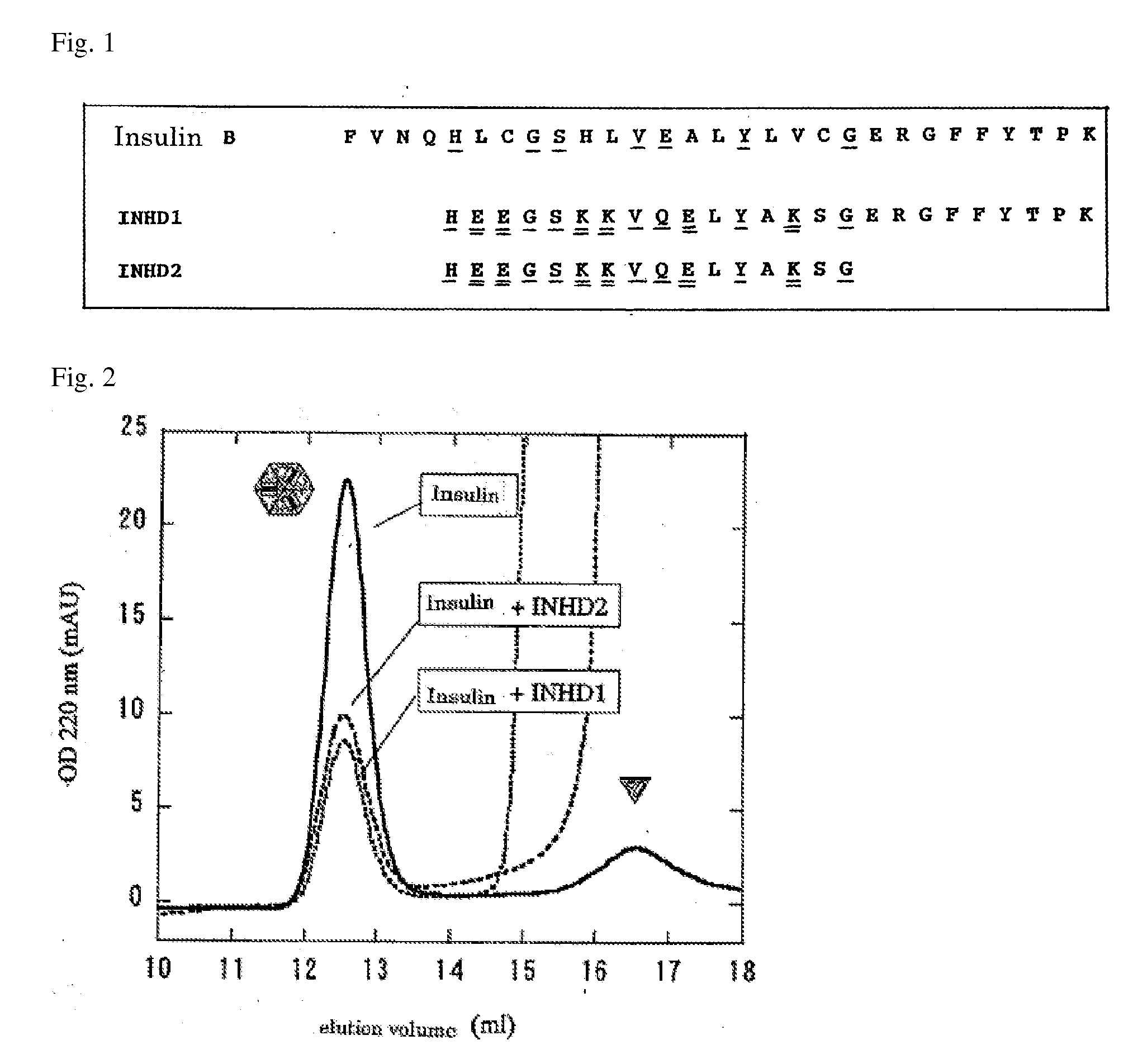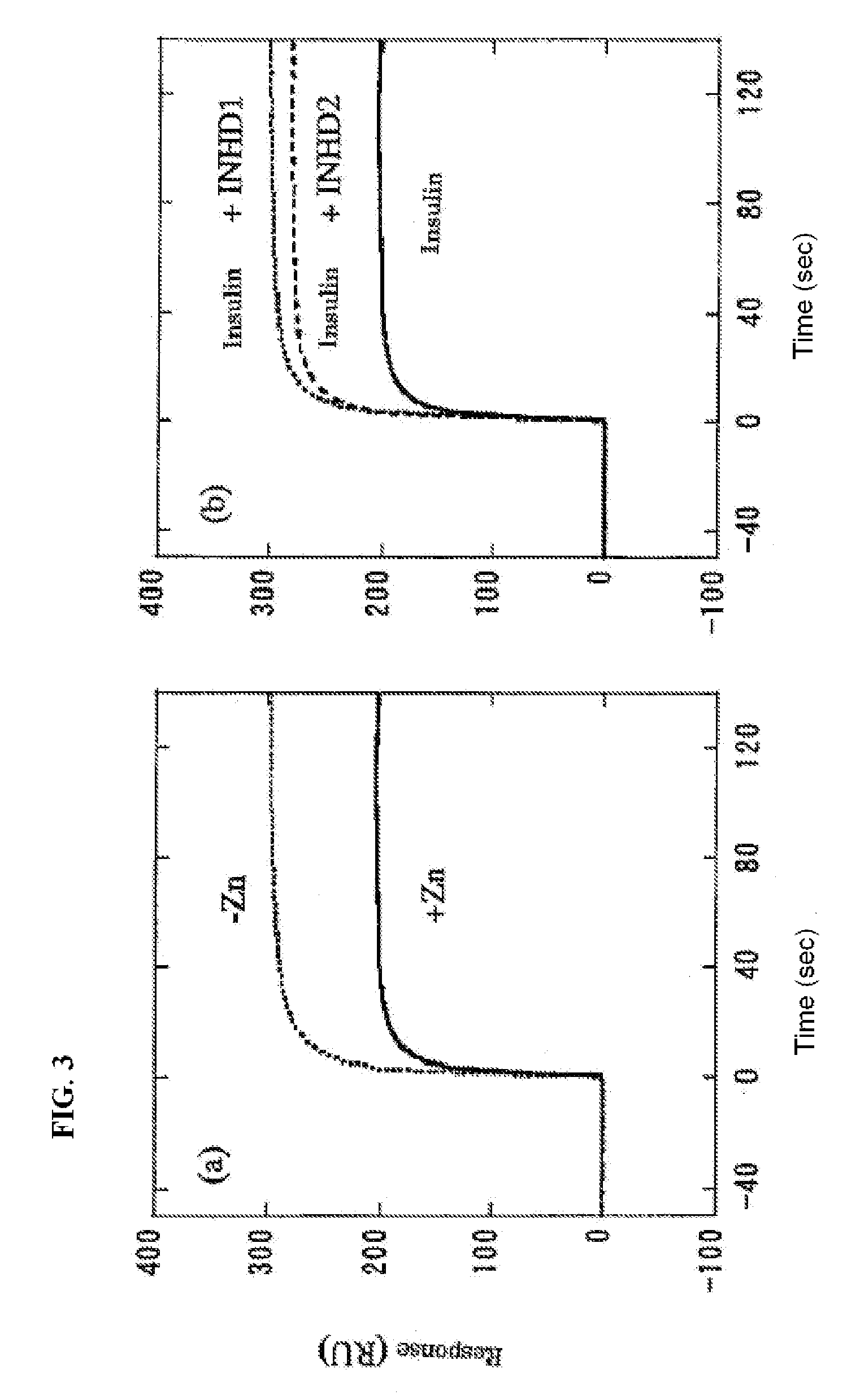Inhibitor of Insulin Multimer Formation
- Summary
- Abstract
- Description
- Claims
- Application Information
AI Technical Summary
Benefits of technology
Problems solved by technology
Method used
Image
Examples
example 1
Design of a Peptide that Inhibits Insulin Dimer and Hexamer Formation (FIG. 1)
[0080]Insulin hexamer formation occurs when the α-helix and the subsequent C-terminal region of B-chain form a dimer formation interface, and then the electrostatic repulsion by Glu13 of B-chain causes a very weak interaction of hexamer formation interfaces. Therefore, a peptide corresponding to the residues at positions 5 to 29 of the B-chain were partially modified as follows:
[0081](1) glutamic acid and lysine residues were introduced into the peptide at intervals of every three residues so that the peptide can easily form an α-helix. SEQ ID NO: 1 represents the amino acid sequence of this designed peptide, and SEQ ID NO: 3 represents the sequence of the insulin B-chain. In the α-helix region of the insulin B-chain, His5, Gly8, Ser9, Val12, Glu13, Tyr16, and Gly20, (indicated by the single underlines in FIG. 1) are the residues which primarily make up the insulin dimer interface. Therefore, glutamic acid...
example 2
Insulin Hexamer Formation
[0084]In order to separately detect insulin hexamers and insulin monomers, gel filtration chromatography was performed. PBS supplemented with 100 μM ZnCl2 was used as a solvent to form hexamers at a concentration of this experiment (5 μM). This is because zinc ion stabilizes insulin hexamers. The results are shown in FIG. 2. For the 5 μM insulin solution, the hexamer was the main peak, and the ratio of the monomer was extremely low.
example 3
Inhibition of Insulin Hexamer Formation by the INHD Peptide
[0085]The insulin solution was subjected to gel filtration chromatography in the presence of the INHD peptide to show inhibition of insulin hexamer formation by the INHD peptide. FIG. 2 shows the results of an experiment where 5 μM insulin and 500 μM INHD1 peptide were mixed. In the presence of the INHD1 peptide, the peak which represents the insulin hexamer significantly decreased, and it was found that the INHD1 peptide inhibited insulin hexamer formation.
[0086]Moreover, in the case of INHD2 peptide, a similar result was obtained although the inhibition of hexamer formation was slightly lower than that for the INHD1 peptide (FIG. 2). The results show that the amino acid residues at positions 1, 4, 5, 8, 9, and 12 in the peptide sequence of SEQ ID NO: 2 are important.
PUM
| Property | Measurement | Unit |
|---|---|---|
| Composition | aaaaa | aaaaa |
Abstract
Description
Claims
Application Information
 Login to View More
Login to View More - R&D
- Intellectual Property
- Life Sciences
- Materials
- Tech Scout
- Unparalleled Data Quality
- Higher Quality Content
- 60% Fewer Hallucinations
Browse by: Latest US Patents, China's latest patents, Technical Efficacy Thesaurus, Application Domain, Technology Topic, Popular Technical Reports.
© 2025 PatSnap. All rights reserved.Legal|Privacy policy|Modern Slavery Act Transparency Statement|Sitemap|About US| Contact US: help@patsnap.com


